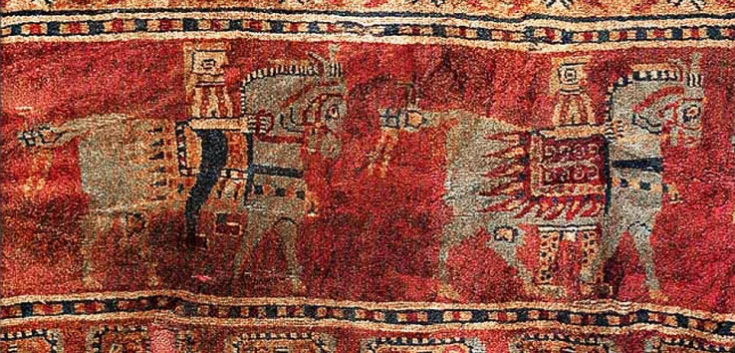he oldest surviving knotted carpet is the Pazyryk rug, excavated miraculously in the frozen tombs of Siberia, dated from the 5th to the 3rd century B.C., now in the Hermitage Museum in St. Petersburg. This square tufted carpet, almost perfectly intact, is considered by many experts to be of specifically Armenian, origin. The eminent authority of ancient carpets, Ulrich Schurmann, says of it:
“From all the evidence available I am convinced that the Pazyryk rug was a funeral accessory and most likely a masterpiece of Armenian workmanship”
When chemists and dye specialists of the Hermitage Museum examined the Pazyryk carpet for various substances, it has been concluded that the red threads used in the carpet were colored with a dye made from the Armenian cochineal, which was anciently found on the Ararat plains. Moreover the technique used to create the Pazyryk carpet is consistent with the Armenian double knot technique. This technique is particularly known as the “Armani baff”, that is “Armenian work” in several rug weaving centers of Iran.
What is interesting to note is that rug fragments discovered in the neighboring Scythian burials in “Bashadar” and “Seneh” do not resemble the Pazyryk rug in style and technique. For example the knots of these rugs are “asymmetrical” as opposed to the “symmetrical” knots of the Pazyryk carpet. Whereas in Armenia, carpet fragments woven with symmetrical knots, similar to the Pazyryk carpet, have been attested from a 7-6th century BCE burial place at Karmir Blur.
Various decorative elements on the carpet also reveal Armenian origin. Regarding the style of decoration Ulrich Schurmann says:
“The artistic device of changing the direction of rows of depicted objects is not an invention typical of the Scyths. It is more likely an artistic device of the people of the Middle East.”
For comparison Schurmann mentions the similarities with the Armenian bronze decorations of the Vannic period. He says:
“Their decor adds further proof that the Pazyryk rug could only have been made in the same [Armenian] district. It is the same style of repeating animals in rows, often changing the direction. The Armenians lived there and as inheritors of the Urartian art may have also have made many of those bronzes.”
Other decorative motives can also be traced to the Middle East and Armenian Highlands. For example the star motives at the center and on the second border are reminiscent of what we often see in Asia Minor from Urartian and the Artaxiad periods.
Urartian period
More: https://www.peopleofar.com/2019/03/27/the-worlds-oldest-rug-was-made-in-armenia/
